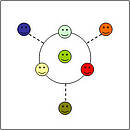
As we have seen, every translation assignment can be seen as a project which requires, in addition to the translating itself, consistent organisational work – project management – in order to assure the quality of the service or product to be delivered. Nevertheless, the project management workflow varies in content and volume depending on the work scenario of the translator or translators.
To illustrate this variety, we can distinguish five categories of work scenario, even if these distinctions are not clear-cut in professional practice. The description of these categories is organised according to the project processes defined in 4. Processes. For each, we present the project management focus in general steps and the work processes that deviate from those occurring in the other work scenarios.
The 5 categories of Work Scenarios

S/he is sitting alone in his/her one-desk office, impersonating the CEO, project manager and translator all at the same time.
As such, he/she will have to perform all organisational and translation tasks and processes described in 3. Tasks and 4. Processes.
| For the freelancer the initiating process involves checking if his/her resources will be sufficient to carry out the assignment, and calculating the time and cost factors in order to submit a solid bid or accept the Purchase Order. |
| No specific features for the freelancer – defining in detail the work to be done and fixing the deadlines and checkpoints for the executing and controlling/monitoring process. |
| No specific features for the freelancer – carrying out the plan specified during the planning process. |
| No specific features for the freelancer – checking and measuring progress in the different project activities. |
| No specific features for the freelancer – formal acceptance by the client of the translated product, revision and evaluation of the project activities, updating of data and materials, systematic archiving of all project files. |
 In many cases the traditional freelancer we just described would have to decline an assignment because s/he would not be able to cover all required working languages or to deliver the translation on time. The alternative is to form a team with other colleagues, sharing the translation work.
In many cases the traditional freelancer we just described would have to decline an assignment because s/he would not be able to cover all required working languages or to deliver the translation on time. The alternative is to form a team with other colleagues, sharing the translation work.
This requires a higher volume of organisational work. In this case, one of the freelancers – usually the one who obtained the assignment – should be appointed to assume the responsibility of project management.
| ||||||||||
|
 The translation company accepts an assignment from a client and, depending on the nature, subject field, language combination(s) and size of the translation, handles it with in-house and/or external translators.
The translation company accepts an assignment from a client and, depending on the nature, subject field, language combination(s) and size of the translation, handles it with in-house and/or external translators.
Unlike the freelancer team, the translation company will usually have documented work processes, possibly a process-oriented quality management system.
| ||||||||||
|
 The translation agency accepts assignments from a client but does not have any in-house translators and thus subcontracts all the translation work to external translators.
The translation agency accepts assignments from a client but does not have any in-house translators and thus subcontracts all the translation work to external translators.
The project processes do not differ much from those that apply to the freelancer team and the translation company. The most important difference is that the volume of high-level communication and coordination with external partners rises with the number of external subcontractors. The project manager has to take care that these more complex communication processes do not result in a loss of quality. Some teamwork communication techniques like 'brainstorming' will be unavailable or feasible only using (costly) technologies.

The translation department of a big company or organisation has only a limited number of 'clients', usually the other departments of the company/organisation.
Being part of a structured body, the translation department is provided with documented work processes and fixed lines of communication. The different project management tasks can be split up and assigned to different persons at different hierarchical levels. Translators will often have access to a range of tools to facilitate their work, such as an in-house terminological database or an in-house server-based translation memory system.
Project management in a translation department is strongly determined by these structural conditions.






